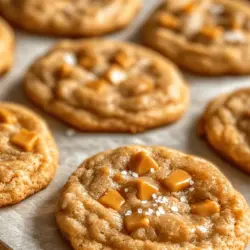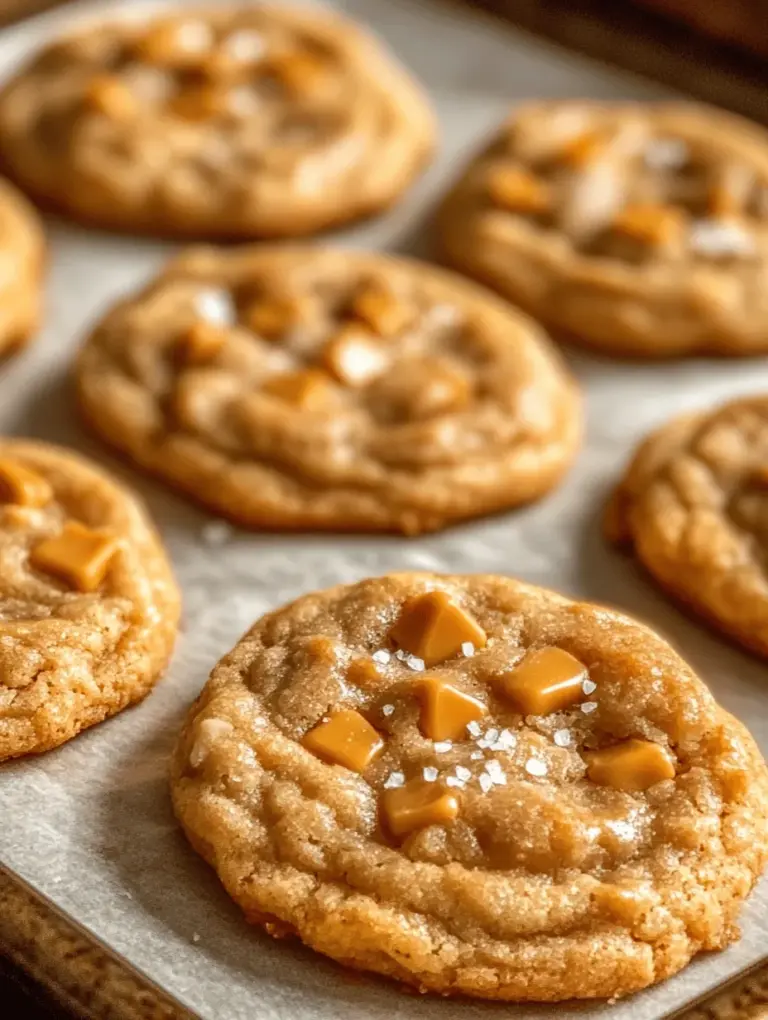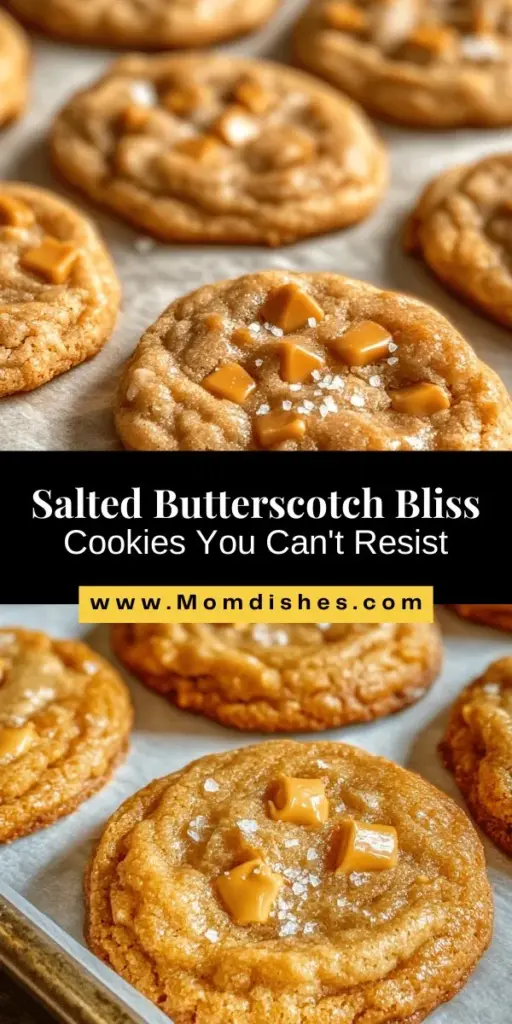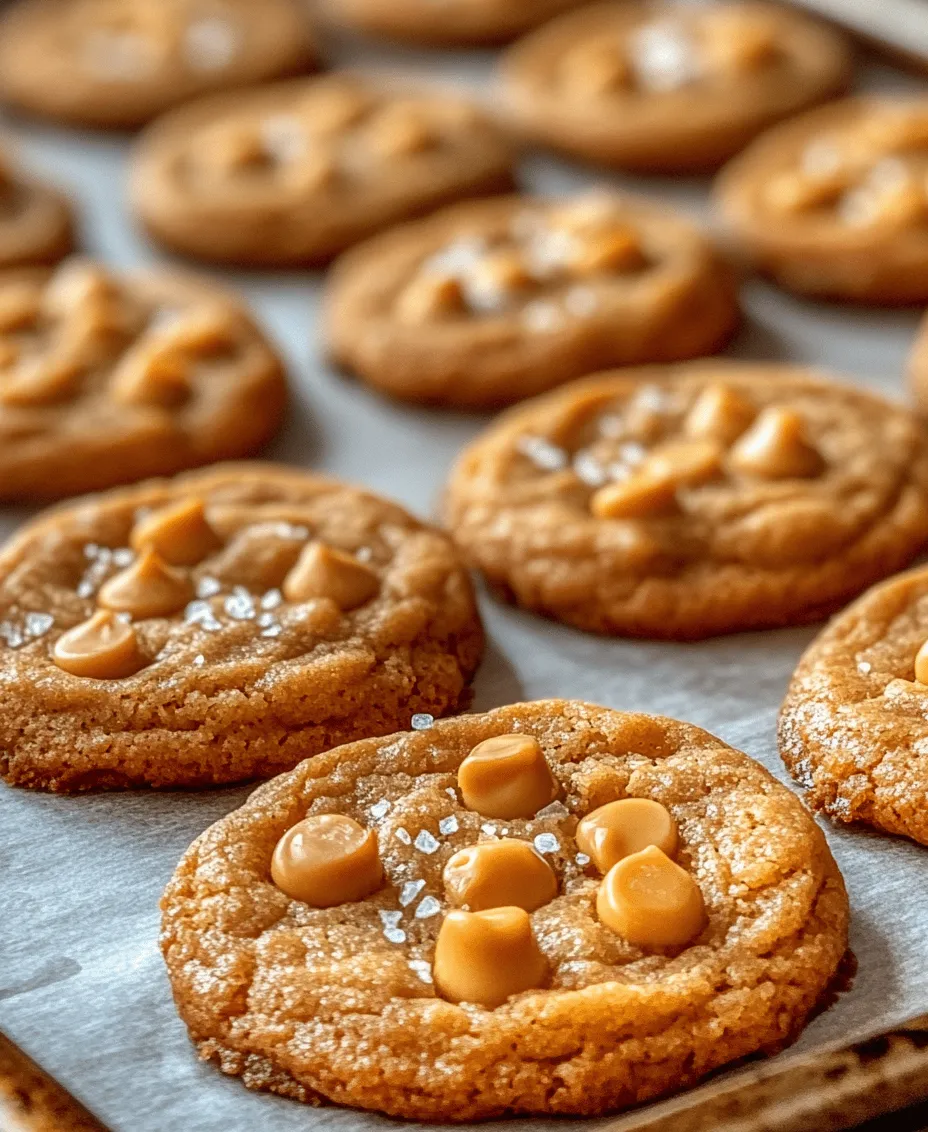Baking is more than just a culinary activity; it’s an art form that brings people together, evokes nostalgia, and indulges the senses. One of the most delightful creations to emerge from the world of baking is the Salted Butterscotch Bliss Cookie. These cookies are the perfect blend of soft, chewy texture and rich, sweet butterscotch flavor, elevated by a sprinkle of flaky sea salt that enhances their taste profile. Whether you’re hosting a casual family gathering, celebrating a special occasion, or simply treating yourself, this recipe is bound to be a crowd-pleaser.
In this article, we will delve into the origins of butterscotch, the science that underpins cookie baking, and provide a comprehensive guide to making these delightful cookies from scratch. So, preheat your oven and let’s embark on this flavorful journey!
Understanding Butterscotch
Exploring the History of Butterscotch
Butterscotch has a rich history that dates back to the 19th century, with roots in British culture. The name “butterscotch” is believed to have originated from the method used to make it—specifically, the process of “scotching” or cutting the mixture before it hardened. Traditionally, butterscotch is made by combining brown sugar and butter, resulting in a sweet, creamy sauce that can be poured over desserts or used as a flavoring in various confections.
The cultural significance of butterscotch is evident in its inclusion in numerous recipes, from candies to puddings, and, of course, cookies. Its unique flavor profile, which is both sweet and slightly nutty, has made it a beloved ingredient across generations. Many associate butterscotch with warm memories of family gatherings, where the tantalizing aroma of freshly baked goods fills the air.
Differences Between Butterscotch and Caramel
While butterscotch and caramel may seem similar, they are distinct in both flavor and preparation. The primary difference lies in the type of sugar used. Butterscotch is made with brown sugar, which imparts a deeper, molasses-like flavor, while caramel typically utilizes white granulated sugar. Additionally, butterscotch often incorporates butter earlier in the cooking process, giving it a creamier texture.
Both butterscotch and caramel can be used interchangeably in some recipes, but understanding the nuances of each can elevate your baking, allowing you to choose the right flavor for your desired outcome. For our Salted Butterscotch Bliss Cookies, the rich, buttery notes of butterscotch will shine through, creating a cookie that is uniquely satisfying.
The Components of Butterscotch Flavor
The Role of Brown Sugar
The heart of butterscotch flavor comes from brown sugar. Unlike granulated sugar, brown sugar contains molasses, which not only contributes sweetness but also adds a depth of flavor and moisture to baked goods. In the case of our cookies, the brown sugar will provide a caramel-like taste while ensuring that the cookies remain soft and chewy.
The Importance of Butter Quality
Butter is another crucial component in the flavor profile of butterscotch. The quality of butter can significantly impact the taste of your cookies. Opting for high-quality, unsalted butter will ensure that you get a rich, creamy flavor without any added saltiness. This is especially important when balancing flavors in our Salted Butterscotch Bliss Cookies, where flaky sea salt will be added for contrast.
The Art of Cookie Baking
Key Baking Techniques
To create the perfect Salted Butterscotch Bliss Cookies, mastering the art of cookie baking is essential. One of the key techniques to understand is the creaming method.
Creaming Method Explained
The creaming method involves beating together sugar and butter until the mixture is light and fluffy. This process incorporates air into the batter, which helps create a tender texture in the final product. When using this method, it’s important to ensure that the butter is at room temperature, as this will help it blend smoothly with the sugar.
Importance of Ingredient Temperature
Ingredient temperature plays a significant role in the baking process. For cookies, it’s crucial that butter is softened to room temperature. Cold butter will not cream properly with sugar, resulting in a denser cookie. Similarly, eggs should be at room temperature to ensure even mixing and proper incorporation into the dough.
Baking Science: What Happens When You Bake Cookies?
Understanding the science behind baking can help you achieve consistently delicious results. When you bake cookies, several chemical reactions occur that influence their final texture and flavor.
The Role of Flour, Sugar, and Fat
Flour provides structure to cookies, while sugar contributes sweetness and helps with browning during baking. Fat, primarily from butter, aids in moisture retention and flavor development. The right balance of these ingredients is essential for achieving the perfect cookie texture—crispy edges with a soft, chewy center.
How Baking Soda Affects Texture
In our Salted Butterscotch Bliss Cookies, baking soda is a crucial ingredient. It acts as a leavening agent, helping the cookies rise and spread while baking. When combined with an acid (like the brown sugar), baking soda creates carbon dioxide bubbles that contribute to the cookie’s lightness. Make sure to measure accurately to avoid overly flat or excessively puffy cookies.
Ingredients Breakdown
To make Salted Butterscotch Bliss Cookies, you’ll need a selection of essential ingredients, each playing a vital role in the final outcome.
Essential Ingredients for Salted Butterscotch Bliss Cookies
– Butter: The backbone of flavor in our cookies. Use high-quality unsalted butter for the best results.
– Sugars: A combination of brown sugar and granulated sugar balances sweetness and texture.
– Eggs: Provide structure, moisture, and richness to the dough.
– Flour and Leavening Agents: All-purpose flour gives structure, while baking soda helps achieve the right texture.
– Butterscotch Chips: The star ingredient that delivers bursts of flavor in every bite.
– Flaky Sea Salt: A finishing touch that enhances the overall flavor profile, adding a savory balance to the sweetness.
Step-by-Step Guide to Making Salted Butterscotch Bliss Cookies
Preparation Overview
Before diving into the baking process, it’s essential to gather all the necessary ingredients and tools. This not only streamlines your workflow but also ensures you have everything on hand to create these delicious cookies.
1. Ingredients: Assemble your butter, sugars, eggs, flour, baking soda, butterscotch chips, and flaky sea salt.
2. Tools: Prepare your baking sheets, mixing bowls, measuring cups and spoons, and a rubber spatula for mixing.
Now that you’re ready with the ingredients and tools, let’s move on to the step-by-step instructions that will guide you through the process of making Salted Butterscotch Bliss Cookies.
Stay tuned for the next part of this article, where we’ll dive into the detailed instructions for creating these scrumptious cookies from scratch!
Prepping the Baking Sheets
Before you dive into the dough-making process, it’s essential to prepare your baking sheets properly. Start by lining your baking sheets with parchment paper or silicone baking mats. These surfaces will prevent the cookies from sticking and help them bake evenly. If you do not have these materials, lightly greasing the baking sheets with butter or cooking spray will also work, but parchment paper is highly recommended for the best results. Prepping your baking sheets ensures that your Salted Butterscotch Bliss Cookies come out perfectly every time.
Mixing the Dough
Creaming the Butter and Sugars
In a large mixing bowl, begin by adding the softened unsalted butter. Using a hand mixer or a stand mixer fitted with a paddle attachment, cream the butter on medium speed until it becomes light and fluffy—this should take about 2 to 3 minutes. Next, gradually add the granulated sugar and packed brown sugar. Continue to mix on medium speed until the mixture is well combined and has a smooth texture. The creaming process is crucial as it incorporates air into the butter, which helps to create a tender cookie.
Incorporating Eggs and Vanilla
Once the butter and sugars are creamed together, it’s time to add the eggs and vanilla extract. Crack two large eggs into the mixture, ensuring they are at room temperature for better incorporation. Add 2 teaspoons of pure vanilla extract to enhance the flavor profile of your cookies. Mix on low speed until the eggs and vanilla are fully combined with the butter-sugar mixture. Scraping down the sides of the bowl with a spatula will help ensure everything is evenly mixed.
Combining Dry Ingredients
Whisking for Even Distribution
In a separate bowl, combine the dry ingredients needed for the cookie dough. This includes 2 ½ cups of all-purpose flour, 1 teaspoon of baking soda, and ½ teaspoon of salt. Whisk these ingredients together until they are well blended. Whisking helps to aerate the flour and evenly distribute the baking soda and salt, which is essential for achieving the right texture in the cookies.
Adding Dry Ingredients to Wet
Gradually add the dry mixture to the wet ingredients, mixing on low speed until just combined. Be careful not to overmix, as this can lead to tough cookies. Stop mixing as soon as you no longer see streaks of flour. The dough should be thick and slightly sticky but manageable. Once combined, you will be ready to add the star ingredient—those delicious butterscotch chips.
Adding Butterscotch Chips
Techniques for Evenly Distributing Chips in the Dough
The key to achieving evenly distributed butterscotch chips lies in the folding technique. Pour in 1 cup of butterscotch chips into the dough. Using a spatula, gently fold the chips into the dough, ensuring they are evenly distributed throughout. This will help prevent clumping and ensure that each cookie has that delightful burst of butterscotch flavor.
Shaping and Baking the Cookies
Proper Spacing on Baking Sheets
Using a cookie scoop or a tablespoon, drop rounded balls of dough onto your prepared baking sheets, leaving about 2 inches of space between each cookie. This spacing is crucial as it allows the cookies to spread while baking. If they are too close together, they will merge into each other, resulting in irregular shapes.
The Importance of Salt Sprinkling Before Baking
Before placing the cookies in the oven, enhance their flavor by sprinkling a small pinch of flaky sea salt on top of each dough ball. This step not only amplifies the butterscotch flavor but also adds a delightful contrast to the sweetness of the cookies. The salt will melt slightly during baking, providing a perfect finish to your Salted Butterscotch Bliss Cookies.
Baking Time and Indicators of Doneness
Visual Cues for Perfect Cookies
Preheat your oven to 350°F (175°C) and bake the cookies for 10 to 12 minutes, or until the edges are golden brown. The centers may appear slightly underbaked, but they will continue to cook as they cool on the baking sheet. Keep an eye on your cookies; they should puff up and become slightly crackled on top.
Cooling Recommendations
Once baked, remove the cookies from the oven and let them cool on the baking sheet for about 5 minutes. This allows them to set and makes them easier to transfer. After that, use a spatula to move the cookies to a wire rack to cool completely. Allowing the cookies to cool properly will ensure they maintain their chewy texture while still being soft and luscious.
Serving Suggestions
Presentation Ideas
When it comes to serving your Salted Butterscotch Bliss Cookies, presentation can elevate the experience. Arrange the cookies on a beautiful platter or stack them in a clear glass jar for a charming display. For an added touch, decorate the top of each cookie with a few extra butterscotch chips before serving. This not only makes them visually appealing but also hints at the deliciousness within.
Pairing with Beverages Like Coffee or Milk
These cookies pair wonderfully with various beverages. Consider serving them with a warm cup of coffee for a delightful afternoon treat or a glass of cold milk for a classic pairing. The richness of butterscotch complements the creaminess of milk, while coffee adds a robust flavor that balances the sweetness of the cookies.
Storing and Enjoying Leftovers
Best Practices for Maintaining Freshness
If you have leftover cookies (though they may not last long!), store them in an airtight container at room temperature. This will keep them fresh for up to one week. If you want to extend their shelf life, consider freezing the cookies. Simply place them in a single layer on a baking sheet and freeze them until solid. Then, transfer them to a freezer-safe bag or container. They can be stored this way for up to three months.
Creative Ways to Use Leftover Cookies
Get creative with any leftover cookies! Crumble them over vanilla ice cream for a delightful dessert or mix them into a milkshake for an indulgent treat. You can even use crumbled cookies as a topping for cupcakes or as a base for a pie crust, adding a unique twist to your baking repertoire.
Nutritional Information
Understanding the Nutritional Value
While these Salted Butterscotch Bliss Cookies are a delicious treat, it’s also good to be aware of their nutritional content. Each cookie contains approximately 150 calories, with 8 grams of fat, 20 grams of carbohydrates, and 1 gram of protein. The exact nutritional values may vary depending on the ingredients used and the size of the cookies.
Healthier Modifications and Substitutions
For those looking to make healthier choices, consider a few modifications. You can substitute half of the all-purpose flour with whole wheat flour for added fiber. Additionally, using a sugar substitute or reducing the amount of sugar can slightly lower the calorie count. Replacing some of the butterscotch chips with dark chocolate chips can also provide a richer flavor with added antioxidant benefits.
Conclusion
Salted Butterscotch Bliss Cookies are more than just a sweet treat; they embody the joy of baking and sharing with loved ones. By understanding the intricacies of baking and the delightful flavor profiles of butterscotch, you can create a cookie that not only satisfies your sweet tooth but also brings people together. Embrace the process, enjoy the aroma of freshly baked cookies, and make lasting memories with every batch. Whether given as gifts or kept for personal indulgence, these cookies are sure to delight family and friends alike. So gather your ingredients, follow the steps, and indulge in the blissful experience of baking and enjoying these delicious cookies.



